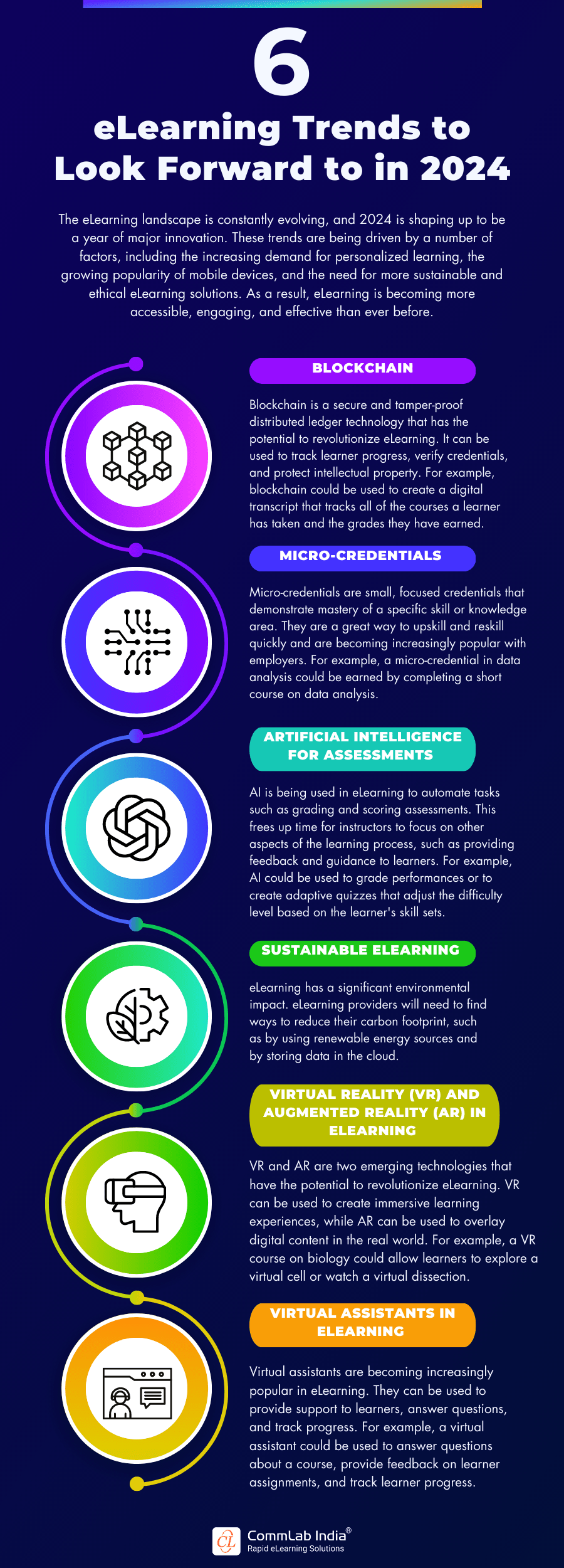

Likewise, in other industries we can see similar technology trends in the eLearning space, in today’s infographic we are exploring 6 exciting eLearning Trends for 2024.
Skillz Middle East has been since 2014 the trusted partner when it comes to eLearning Content creation tools, eLearning platforms, and eLearning innovations in the Middle East. Technology partners are the core success of our efforts in this industry. Adobe, Microsoft, Sprylabs, and SAP are leading platform providers when it comes to industry-leading technologies.
The statement, “The eLearning landscape is changing rapidly.”, we can only underline that vendors not keeping pace on this are quickly disappearing. 2024 arrived and it is about time to look into trends that are predicted also in this industry. Personalization, driven by artificial intelligence to the integration of immersive technologies like virtual reality and augmented reality, will continue in 2024. Audio Visual content is king and technologies around these tools are advancing learners’ experience and personalized content creation without spending many hours in the creation generation.
Tell me and I forget. Teach me and I remember. Involve me and I learn.
– Benjamin Franklin
AI technology is also in this space key and gives us a bright future.
In the below infographic from CommLab India blog covers 6 Exciting eLearning Trends for 2024 that are shaping the future of learning, along with their impact on learners and the challenges that organizations face when utilizing them.
Blockchain
Blockchain is a secure and tamper-proof distributed ledger technology that has the potential to revolutionize eLearning. It can be used to track learner progress, verify credentials, and protect intellectual property. More than this blockchain is an open technology that lets everyone proof the results even at a later point in time. For example, blockchain could be used to create a digital transcript that tracks all of the courses a learner has taken and the grades they have earned.
Micro-Credentials
Micro-credentials are small, focused credentials that demonstrate mastery of a specific skill or knowledge area. They are a great way to upskill and reskill quickly and are becoming increasingly popular with employers. For example, a micro-credential in data analysis could be earned by completing a short course on data analysis.
AI (Artificial Intelligence) for Assessment
Al is being used in eLearning to automate tasks such as grading and scoring assessments. This frees up time for instructors to focus on other aspects of the learning process, such as providing feedback and guidance to learners. For example, Al could be used to grade performances or to create adaptive quizzes that adjust the difficulty level based on the learner’s skill sets.
Sustainable eLearning
eLearning has a significant environmental impact. eLearning providers will need to find ways to reduce their carbon footprint, such as by using renewable energy sources and by storing data in the cloud.
Virtual Reality (VR) and Augmented Reality (AR) in eLearning
VR and AR are two emerging technologies that have the potential to revolutionize eLearning.VR can be used to create immersive learning experiences, while AR can be used to overlay digital content in the real world. For example, a VR course on biology could allow learners to explore a virtual cell or watch a virtual dissection.
Virtual Assistance in eLearning
Virtual assistants are becoming increasingly popular in eLearning. They can be used to provide support to learners, answer questions, and track progress. Bots that perdict the question / anwser concept of learners are key successors. For example, a virtual assistant could be used to answer questions about a course, provide feedback on learner assignments, and track learner progress.


![Social Media Marketing Trends for 2026 [Infographic] 15-Social-Media-Marketing-Trends-for-2026](https://www.skillzme.com/wp-content/uploads/2025/12/feature-image-15-Social-Media-Marketing-Trends-for-2026-200x105.jpg)
![How Markets Perform during US Elections [Infographics] hero-image-how-markets-perform-during-us-elections](https://www.skillzme.com/wp-content/uploads/2024/11/hero-image-how-markets-perform-during-us-elections-200x200.jpg)
![Super Bowl LIX in New Orleans 2025 [Infographic] hero-image-superbowl-2025](https://www.skillzme.com/wp-content/uploads/2025/02/hero-image-superbowl-2025-200x200.jpg)


Recent Comments